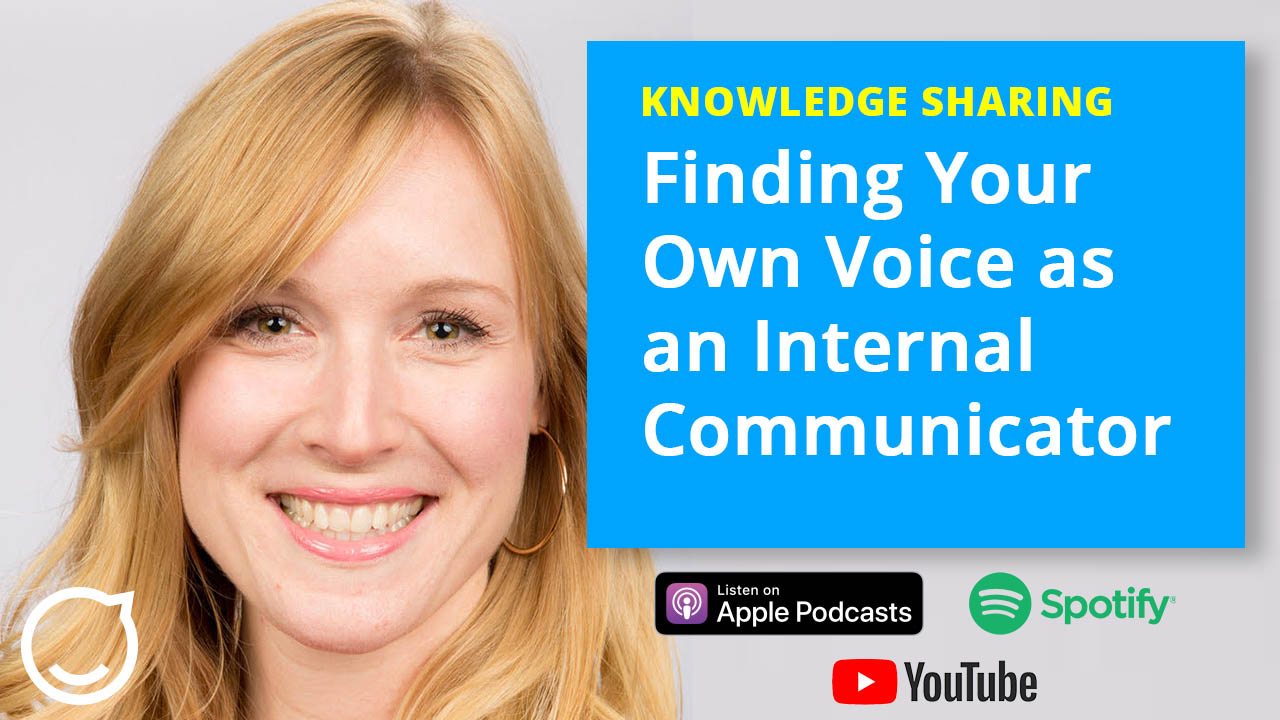Meet Kristin Hancock, employee engagement professional and founder of her own business to connect and engage workforces everywhere. Kristin’s career has given her years of experience and knowledge on business, media production, HR issues, and most importantly internal communications.
“In terms of KPIs and what to measure… one of my favorite things to measure on an employee survey is… Would you recommend a friend to work here? That’s a really powerful question to ask because if most people are saying no, that means that maybe they’re just sticking it out, going through the motions to keep their paycheck… The other powerful question I love asking is how people feel on Sunday night… that says a lot about your culture.”
Kristin
To listen to the full interview with Kristin, check out the full episode below:
She sat down with us to speak specifically about internal communications and her journey navigating the industry she is so happy to be apart of. From working at different companies to starting her own, Kristin has dealt with many internal communications issues for workforces of all sizes. She has plenty of advice to give other internal communicators out there who are trying to find their voice in the organization they strive to connect and engage with.
Kristin began by telling us how she defines internal communications. She believes while almost everyone in the business world knows what an internal communicator actually does, they are unfamiliar with the job title itself. Kristin defines herself and her profession as being, “about your employees being fulfilled at work, it’s about how the employee experience is, whether that’s onboarding or training or all those kinds of pieces.” Everything that defines the employee experience and engagement in a workplace is what Kristin is focused on, and she works with all levels of leadership to facilitate effective communication among members of the organizations to improve this experience and engagement.
We asked Kristin to tell us a little bit about her career that has led her to internal communications. She shared she originally went to school for business but was quickly drawn to the communications side of the business world after realizing she could write and speak for a living. Based in Winnipeg, Manitoba, a relatively small city, Kristin has since been able to gain experience working in all kinds of organizations and doing all kinds of communications. Before finding her love for internal communications, Kristin worked in PR, media relations, fundraising, and external communications, but none of these experiences compared to her passion for internal communications, where she “felt that the communications world and the business world could make the most impact, so that’s where I attached myself to.”
“Part of why I’ve become so passionate about [internal communications] is because I’ve seen the impact in both ways. I’ve seen the really positive impact when you have a thriving culture and employees who are fulfilled and enjoy coming to work everyday. I’ve also seen the other side of it, where people don’t want to go to work everyday and dread being there.”
Kristin
In discussing the work she has done with companies and their internal communications strategies, Kristin shared “Part of why I’ve become so passionate about [internal communications] is because I’ve seen the impact in both ways. I’ve seen the really positive impact when you have a thriving culture and employees who are fulfilled and enjoy coming to work everyday. I’ve also seen the other side of it, where people don’t want to go to work everyday and dread being there.” Observing workplace cultures and identifying the problems within them has become a strong suit of Kristin, who encourages other internal communicators to start by “looking back and looking at the big picture but also looking at the little nuances. What is your culture in its default state? … It’s not going to help you to build anything without knowing that.”
“Spoiler alert: if you launch a new intranet app, a shiny tool… but your workplace culture sucks, the tool isn’t going to work.”
Kristin
Kristin noted that launching a new tool to improve a company’s internal communications strategy can be a great idea, as it can often bring excitement into the comms conversation and involve workers who are bored with the old tools. On the other hand, she warns against believing that a new tool will solve all of your comms problems if done wrong. She notes “Spoiler alert: if you launch a new intranet app, a shiny tool… but your workplace culture sucks, the tool isn’t going to work.” In Kristin’s experience, it is less about the technology and more about the actual culture and human interaction that is going on. Culture is what determines if people are happy at work or not and “if you have a culture where leadership controls the message, you likely also have a culture where employees have a fear of owning that message as well. It’s about flipping that whole script so part of it is that leaders are comfortable letting other people be empowered but also letting those other people know that it’s okay for you to comment or post or share or like, those kinds of things.”
“Yes it’s about the technology and it’s about the tool, but it’s so much more about the culture… If you have a culture where leadership controls the message, you likely also have a culture where employees have a fear of owning that message as well. It’s about flipping that whole script so part of it is that leaders are comfortable letting other people be empowered but also letting those other people know that it’s okay for you to comment or post or share or like, those kinds of things.”
Kristin
There is a lot to consider before deciding to launch a new internal comms tool in an organization but if you do decide to do so, Kristin notes that one of the most important things to remember is “Finding people within your organization who are champions of your messaging; that is, I think, the secret sauce in launching a new tool, in rolling out a new strategy.” By finding people who agree with your ideas and feel empowered by the ability to have a voice in the internal communications strategy, whether it be on a mobile app, intranet, or something else, you can create a team of champions who will advocate for you and convince other employers to also get on board with your strategy. Empowerment is really powerful for the often small internal communications teams in large organizations.
Regarding what kind of content to leverage with your new tool, Kristin spoke with us about the power of video. She spent some of her time in school studying video production, and while it is not her favorite platform for internal comms content, she understands the benefits to using it and didn’t hesitate to share with us the importance of knowing when and how to use it: “Half the reason people watch the Superbowl is for the Superbowl ads because it’s video, it’s engaging, it’s emotional, it tells a story… If you are in internal comms, then you are in sales and you are in marketing and you are in advertising and you are in PR, and all of those departments use video to sell a product or a service, and there’s no reason why we shouldn’t be using video to sell an engagement story or strategy, or a new initiative or tool.” Video production is a great way to engage employees, especially if what they see on the video is familiar to them, such as their own manager or office space. Kristin notes that high production value video is not always necessary in the internal comms industry, because “if you have a district manager who once a month shares a message about something and they’re sitting at their desk using their iphone to shoot the video, that’s relatable… it’s an easier level playing field.” Employees don’t need to be impressed by the quality of video content being given to them, they need to be impressed by the information being given to them. Therefore, Kristin advises other communicators not to worry about high production value video as long as their message is effective.

When it comes to internal communications, it can be hard to measure successes and failures. Kristin notes that she has gone through this herself but has since found ways to overcome it. She tells us “one of my favorite things to measure on an employee survey is would you recommend a friend to work here? That’s a really powerful question to ask because if most people are saying no, that means that maybe they’re just sticking it out, going through the motions to keep their paycheck… The other powerful question I love asking is how people feel on Sunday night… that says a lot about your culture.” These two questions give so much insight into how employees are feeling about their work and the way that management treats and engages with them. Surveying employees like this can be a great tool for internal communicators who are struggling to figure out their workplace culture so they can build on it with better communication strategies.
A lack of measurement can make working in internal communications scary for some, as the industry is relatively new and “there is no charted path, so we are all doing that right now and that’s scary but also really awesome that we get to create and invent and decide what is helpful for measurement and how we should be sharing messages… we need to flip this fear into an excitement about the industry and charting new territory.”
Kristin is hopeful for the future of the internal communications industry though, as she knows that there are many marketing and PR professionals out there who are capable of doing the job, they just don’t know it. She describes the role of an internal communicator as someone “who is a connector of people, who is very creative, who can do marketing and target audiences.” These are the same tasks that marketers and PR professionals do every day, just externally rather than internally at the company. Understanding the role of internal communicators as marketers and connectors within the organization can take away some of the fear around the unknown industry, encouraging more people in similar jobs to explore the IC community.
After a great conversation, Kristin left us with a piece of advice for all internal communicators: “Internal comms pros, we all need to put our crowns on and own our roles.” Kristin wants internal communicators to have more of a voice in their organizations, as she knows they play a vital role in the happiness and productivity of their workers. She encourages internal communicators to fear less about their roles and instead trust more in their abilities to create positive change in the workplace.
Thanks for the interview, Kristin! We wish you the best in your internal communications endeavours and hope to see more internal communicators wearing their crowns like you do!



